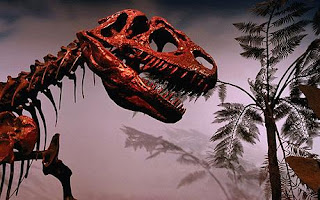 Dinosaurs were able to survive colder temperatures than was previously thought, according to new research that casts doubt on theories that they were killed off by plummeting temperatures caused by climate change.
Dinosaurs were able to survive colder temperatures than was previously thought, according to new research that casts doubt on theories that they were killed off by plummeting temperatures caused by climate change.Palaeontologists have unearthed a rich variety of dinosaur fossils in an area that would have been one of the most northerly regions of the world in the period just before the giant reptiles died out, between 65 and 68 million years ago.
At the time, the world was far warmer and the continents were still to move to their current positions. Northeastern Russia, where the remains have been found, would have been just 1,000 miles from the North Pole, inside what is now called the Arctic Circle. Average temperatures would have been around 50F (10C).
Fossil hunters found remains of duck billed dinosaurs, fossilised teeth belonging to relatives of the heavily armoured Triceratops and even teeth belonging to relatives of the giant meat eater Tyrannosaurus rex.
The palaeontologists, based at the Royal Belgian Institute of Natural Sciences, also found fragments of dinosaur egg shells alongside the Arctic dinosaur remains, providing the first proof the animals were able to reproduce in these relatively cold, northern climates.
Dinosaurs have typically been thought of as being tropical creatures, but the discovery suggests they were able to survive in far colder conditions than had been appreciated.
One of the most common theories for the extinction of the dinosaurs was that the global climate cooled to the point that the animals could not survive. But the new discovery suggests dinosaurs were capable of adapting to cold conditions.
Professor Pascal Godefroit, who led the research on the polar dinosaurs, believes they faced a far more speedy decline, most likely caused by a massive meteor impact around 66 million years ago.
"For the first time we have firm evidence that these polar dinosaurs were able to reproduce and live in those relatively cold regions," he said.
"There is no way of knowing for sure, but dinosaurs were probably warm blooded just like modern birds, which are the direct descendants of dinosaurs.
"We have no remains of cold-blooded reptiles such as turtles, crocodilians and lizards in that area which suggests it was too cold for them.
"The dinosaurs were incredibly diverse in polar regions – as diverse as they were in tropical regions. It was a big surprise for us."
Among the dinosaur remains to have been found at Kakanaut, in northeastern Russia, include fossils of bipedal herbivores known as Ornithopods along with larger, lumbering plant eaters, similar to Ceratop dinosaurs, known as Edmontonia.
Teeth belonging to small meat eaters, including the 6ft long Troodon, which carried retractable claws, and relatives of the Velociraptors made famous by Jurassic Park, known as Dromaeosaurids were unearthed.
Remains of large tyrannosaurid dinosaurs, relatives of the formidable Tyranosaurus Rex, were also discovered.
Previously the most northerly dinosaur remains to be found have been in Alaska, but scientists have always assumed the creatures migrated south during the winter months to avoid the cold and long periods of darkness.
Professor Godefroit and his team, however, now claim they have evidence to suggest dinosaurs were year round residents of high latitudes and fed on evergreen plants during the winter. They have reported their findings in the German journal Naturwissenschaften.
He believes that the findings that so many dinosaurs were living in relatively cold regions right up until the time they became extinct, provides strong evidence against theories that climate change gradually killed them off.
Instead he believes debris thrown up by the meteor impact that created the Chicxulub Crater, on the Yucatan Peninsula in Mexico, blanketed the atmosphere and reduced the amount of sunlight reaching the planet's surface.
This would have caused a dramatic reduction in the amount of plant life on the planet, which would have caused a rapid collapse in the food chain as the large plant eating dinosaurs died out, as well as the meat eaters that preyed upon them.
He said: "The meteor impact would have led to the equivalent of a global polar night that could have lasted for several years. Even the polar dinosaurs that were used to finding food in such conditions would have struggled for that length of time."
Robert Spicer, from the Open University, told the scientific journal Nature that the findings show that dinosaurs were far more robust than had been realised.
He said: "It makes me ask very serious questions about what could make animals that were resilient enough to live under these conditions to suddenly go extinct."
No comments:
Post a Comment